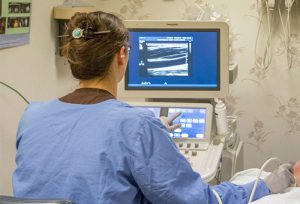Career Outlook, Gainful Employment
W ith a large aging population, the need to diagnose medical conditions using affordable imaging technology is likely to increase. Sonographers are needed to provide an alternative to radiation imaging techniques. The Bureau of Labor Statistics expects this profession to grow much faster than average over the next decade. The average salary for a diagnostic medical sonographer is $71,000, with that figure dependent on experience, certification, and location.
ith a large aging population, the need to diagnose medical conditions using affordable imaging technology is likely to increase. Sonographers are needed to provide an alternative to radiation imaging techniques. The Bureau of Labor Statistics expects this profession to grow much faster than average over the next decade. The average salary for a diagnostic medical sonographer is $71,000, with that figure dependent on experience, certification, and location.
With additional training and education, some sonographers may move into supervisory positions or become an advanced sonographer. Earning an advanced degree will allow some sonographers to become educators and researchers.
A diagnostic medical sonographer, also known simply as a sonographer, uses imaging equipment and soundwaves to form images of many parts of the body, known as diagnostic medical ultrasound imaging. They are trained to acquire and analyze these sonographic images for image quality and submit them to a qualified physician for diagnostic interpretation. These images are used to help doctors diagnose and treat many medical conditions.
Since ultrasound is a non-invasive way to visualize internal organs, it is often the first imaging test performed when disease is detected. Diagnostic medical sonographers, therefore, have an important role in conducting and interpreting initial imaging tests that may help narrow down a patient’s diagnosis and quickly get them the care they need.
Scope of practice, typical job duties, roles, and responsibilities of a diagnostic medical sonographer include:
-
- Operating imaging equipment, and reviewing images to be sure they are of good quality and helpful for diagnosis.
- Identifying normal and abnormal imaging results, communicating a summary of the results to physicians or other health professionals, and alerting physicians to urgent problems.
- Preparing patients for procedures and educating patients throughout the ultrasound exam.
- Reviewing patient medical history, recording imaging results in patient records, and coordinating care with various departments within the hospital or clinic.
Diagnostic medical sonographers work with doctors, nurses, and patients of all ages, from infants to the elderly. Diagnostic medical sonographers can specialize in a variety of areas. For example, vascular technologists create images of blood vessels, while obstetric and gynecologic sonographers specialize in imaging the female reproductive system. Other specialized sonographers may focus on imaging the abdomen, musculoskeletal system, or blood vessels. A sonographer who focuses on imaging the heart is called an echocardiographer, and they provide visualizations of patients’ heart valves and cardiac arteries. While some employers may want specialized sonographers, many general sonographer positions will require imaging experience in several of these areas.
Diagnostic medical sonographers are often found performing ultrasound procedures at a patient’s bedside, but also may work with imaging machines in a dedicated room within the hospital or clinic. Most diagnostic medical sonographers work full time, and some may be asked to work evenings, weekends, or on holidays depending on their employer. Often, the role requires you to be on your feet for most of the work day. While diagnostic medical sonographers work predominantly in hospitals, they can also be employed in doctors’ offices and medical and diagnostic labs.
